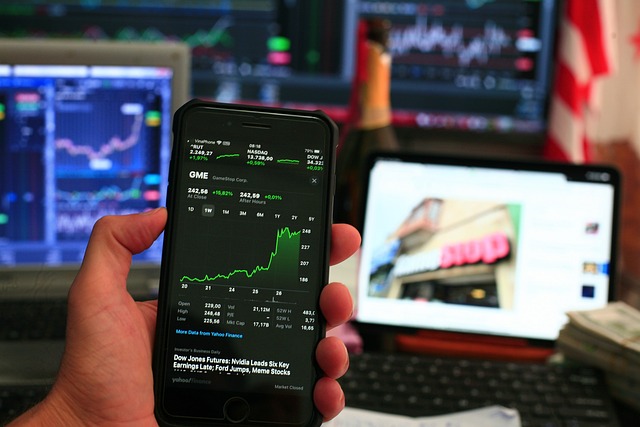Master Day Trading: Achieve Financial Goals with Strategic Routines
Day trading is a high-stakes investment strategy focusing on buying and selling financial instruments within a single day, leveraging short-term price swings. Success demands swift decisions, advanced tools (real-time data, charting software), r…….

Day trading is a high-stakes investment strategy focusing on buying and selling financial instruments within a single day, leveraging short-term price swings. Success demands swift decisions, advanced tools (real-time data, charting software), rigorous risk management, and deep market knowledge. Defining clear financial goals is crucial, shaping risk tolerance and trading methods. Successful day traders use stop-loss orders, diversify portfolios, and closely monitor economic indicators, company developments, and global events to inform decisions and safeguard capital. A structured routine with consistent analysis, regular breaks, and a standardized trade approach is key to navigating this dynamic market effectively.
“Uncover the power of day trading as a strategic approach to achieving financial goals. This comprehensive guide demystifies the fundamentals, empowering beginners to navigate the markets effectively. From setting ambitious yet realistic financial objectives to implementing proven strategies and tools, we’ll explore essential techniques. Learn risk management strategies and gain insights into informed decision-making. Discover how to build a consistent day trading routine, transforming your financial aspirations into reality, one trade at a time.”
- Understanding Day Trading: Unveiling the Basics
- Setting Clear Financial Goals for Day Trading
- Strategies and Tools for Successful Day Traders
- Managing Risks and Making Informed Decisions
- Building a Sustainable Day Trading Routine
Understanding Day Trading: Unveiling the Basics
Day trading, a dynamic and complex strategy, involves buying and selling financial instruments within the same trading day, aiming to capitalize on short-term price fluctuations. It’s a fast-paced approach that demands a keen understanding of market dynamics and an ability to make swift decisions. Unlike traditional investing, where positions may remain open for weeks or months, day traders seek to profit from intraday price movements, often leveraging advanced technical analysis tools and real-time data.
The essence of day trading lies in its ability to offer both significant potential gains and substantial risks. It requires a disciplined approach, rigorous risk management strategies, and a deep knowledge of various financial markets. Traders must be adept at identifying profitable opportunities, managing their exposure, and adapting to the ever-changing market conditions. This high-stakes environment is not for the faint of heart but can be an attractive path for those willing to invest time in learning and mastering the art of day trading.
Setting Clear Financial Goals for Day Trading
Before diving into the fast-paced world of day trading, it’s essential to define your financial goals. What is day trading? It’s a high-frequency approach to buying and selling financial instruments within the same trading day, taking advantage of small price fluctuations. However, this strategy requires clear objectives to stay focused and motivated.
Setting specific and achievable financial targets is crucial. Are you aiming to generate a steady income, boost your savings, or maybe retire early? Your goals will guide your risk appetite, trading style, and the amount of capital you allocate. Having well-defined objectives also helps in measuring success and making informed decisions during the dynamic landscape of day trading.
Strategies and Tools for Successful Day Traders
Day trading, a dynamic and high-octane approach to investing, involves buying and selling financial instruments within the same trading day. To succeed in this fast-paced environment, traders rely on a combination of strategies and tools tailored to capitalize on short-term price fluctuations. These include technical analysis, where charts and indicators are used to predict market movements based on historical data. Traders also employ risk management techniques like stop-loss orders, which automate the process of selling an asset if it reaches a certain price, limiting potential losses.
The right tools are pivotal for efficient day trading. This includes robust trading platforms offering real-time market data, advanced charting tools, and automated trading capabilities. High-speed internet connections ensure that traders can execute trades swiftly, staying ahead of the market’s rapid changes. Additionally, a good trading journal helps track performance, identify patterns, and make informed decisions by analyzing past trades and learning from both successes and failures.
Managing Risks and Making Informed Decisions
In the fast-paced world of what is day trading, managing risks and making informed decisions are paramount to achieving financial goals. Successful day traders don’t just bet on market fluctuations; they employ strategic risk management techniques to protect their capital. This involves setting clear stop-loss orders to limit potential losses, diversifying their portfolio across various assets, and meticulously analyzing market trends and news to anticipate price movements.
By staying informed about economic indicators, company developments, and global events, day traders can make more calculated decisions. They use advanced tools like charting software and real-time data feeds to identify trading opportunities and exit strategies. This proactive approach ensures that each trade is not just a guess but a well-informed step towards meeting their financial objectives.
Building a Sustainable Day Trading Routine
Day trading, a dynamic and intense approach to investing, involves buying and selling financial assets within the same trading day. It requires a structured routine to stay consistent and disciplined, which is key to achieving financial goals. Establishing a sustainable day trading routine begins with setting clear objectives and defining risk parameters. Traders should dedicate specific time slots for market analysis, keeping up-to-date with economic calendars and news releases that can impact their chosen assets.
A disciplined routine includes regular breaks to prevent mental fatigue, ensuring traders remain alert and focused. Implementing a standardized trade entry and exit strategy is essential. This could involve using technical indicators, chart patterns, or fundamental analysis to make informed decisions. Consistency in execution fosters confidence, allowing traders to adapt and refine their strategies over time, ultimately contributing to the achievement of financial objectives in the fast-paced world of day trading.
Day trading, understood as an intensive trading strategy focused on short-term gains, can be a powerful tool for achieving financial goals. By setting clear objectives, employing effective strategies, and carefully managing risks, individuals can navigate the complexities of what is day trading and build a sustainable routine. This approach equips traders with the necessary skills to make informed decisions, ultimately enhancing their chances of success in this dynamic market.







